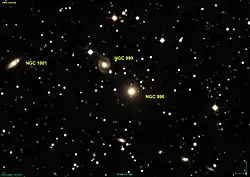NGC 996
NGC 996 is an elliptical galaxy of the Hubble type E0 in the constellation Andromeda. It is estimated to be 210 million light years from the Milky Way and has a diameter of approximately 75,000 ly. The supernova SN 1996bq occurred in this galaxy.[4] NGC 996 was discovered on December 7, 1871 by astronomer Édouard Stephan.[5][6][7]
| NGC 996 | |
|---|---|
 DSS image of NGC 996 (center) | |
| Observation data (J2000 epoch) | |
| Constellation | Andromeda |
| Right ascension | 02h 38m 39.865s[1] |
| Declination | +41° 38′ 51.27″[1] |
| Redshift | 0.015409[2] |
| Helio radial velocity | 4584 km/s[2] |
| Distance | 203.3 Mly (62.34 Mpc)[3] |
| Apparent magnitude (B) | 14.5[2] |
| Characteristics | |
| Type | E[2] |
| Other designations | |
| UGC 2123, MCG+07-06-045, PGC 10015[2] | |
See also
References
- Skrutskie, M. (2006). "The Two Micron All Sky Survey (2MASS)". The Astronomical Journal. 131 (2): 1163–1183. Bibcode:2006AJ....131.1163S. doi:10.1086/498708.
- "NGC 996". SIMBAD. Centre de données astronomiques de Strasbourg. Retrieved 2020-06-03.
- Crook, Aidan C.; Huchra, John P.; Martimbeau, Nathalie; Masters, Karen L.; Jarrett, Tom; Macri, Lucas M. (2007). "Groups of Galaxies in the Two Micron All Sky Redshift Survey". The Astrophysical Journal. 655 (2): 790–813. arXiv:astro-ph/0610732. Bibcode:2007ApJ...655..790C. doi:10.1086/510201. S2CID 11672751.
- "SN 1996bq". SIMBAD. Centre de données astronomiques de Strasbourg. Retrieved 2020-06-03.
- Ford, Dominic. "The galaxy NGC 996 - In-The-Sky.org". in-the-sky.org. Retrieved 2020-03-24.
- "Revised NGC Data for NGC 996". spider.seds.org. Retrieved 2020-03-24.
- "Your NED Search Results". ned.ipac.caltech.edu. Retrieved 2020-03-24.
This article is issued from Wikipedia. The text is licensed under Creative Commons - Attribution - Sharealike. Additional terms may apply for the media files.